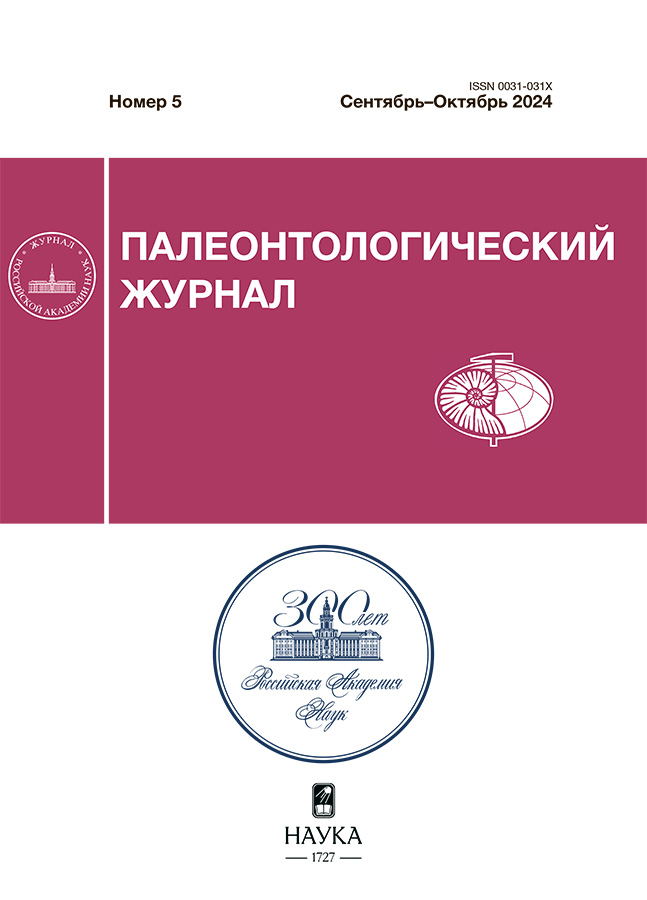Morphology and Histology of Salamander Femoral Bones of the Genus Kiyatriton (Caudata) from the Middle Jurassic and Early Cretaceous of Western Siberia
- Authors: Skutschas P.P.1, Saburov P.G.1, Uliakhin A.V.2, Kolchanov V.V.1
-
Affiliations:
- Saint Petersburg State University
- Borissiak Paleontological Institute, Russian Academy of Sciences
- Issue: No 5 (2024)
- Pages: 95-104
- Section: Articles
- URL: https://ruspoj.com/0031-031X/article/view/684739
- DOI: https://doi.org/10.31857/S0031031X24050104
- EDN: https://elibrary.ru/QURYLS
- ID: 684739
Cite item
Abstract
The paper describes the morphology and histological structure of salamander femora of the genus Kiyatriton: K. krasnolutskii from the Middle Jurassic (Bathonian) Berezovsk Quarry locality in the Krasnoyarsk krai and K. leshchinskiyi from the Lower Cretaceous (Aptian) Shestakovo 1 locality in the Kemerovo oblast. The femur of Kiyatriton is characterized by the presence of a large spur-shaped trochanter, a developed high trochanter crest, a large ventral fossa (fossa trochanterica) and a bean-shaped proximal end in cross-section. The histological structure is characterized by the presence of a thick, almost avascular cortex formed by both periosteal primary and secondary endosteal bone; thick periostelial cortex, consisting of a parallel-fibred bone matrix and bearing cyclical growth marks (annuli, LAGs), including double LAGs; a thick endosteal cortex consisting of a lamellar bone matrix; the presence of a small medullary cavity; the presence of the Kashchenko line; absence of calcified cartilage; absence of bone remodeling (erosion bays, secondary osteons, resorption of the walls of the medullary cavity). Similarities in the morphological and histological structure of the femora of Kiyatriton and small-sized modern metamorphosing salamanders (large spur-shaped trochanter of the femur, deep ventral fossa, rounded proximal end of the femur, avascular periosteal cortex with growth marks, thick layer of endosteal bone forming the inner part of the cortex, small medullary cavity) indicate that members of the genus Kiyatriton were metamorphosing salamanders with a terrestrial adult stage. The similarity in the structure of the femora of different-aged Middle Jurassic and Early Cretaceous representatives of Kiyatriton indicates that the biological characteristics (growth pattern, presence of metamorphosis) have not changed for about 40 million years.
Full Text
About the authors
P. P. Skutschas
Saint Petersburg State University
Author for correspondence.
Email: p.skutschas@spbu.ru
Russian Federation, Saint Petersburg, 199034
P. G. Saburov
Saint Petersburg State University
Email: p.saburov@spbu.ru
Russian Federation, Saint Petersburg, 199034
A. V. Uliakhin
Borissiak Paleontological Institute, Russian Academy of Sciences
Email: avu90@mail.ru
Russian Federation, Moscow, 117647
V. V. Kolchanov
Saint Petersburg State University
Email: veniamin.kolchanov@mail.ru
Russian Federation, Saint Petersburg, 199034
References
- Гуртовой Н.Н., Матвеев Б.С., Дзержинский Ф.Я. Практическая зоотомия позвоночных. Земноводные. Пресмыкающиеся. М.: Высшая школа, 1978. 407 c.
- Ashley-Ross M.A. The Comparative myology of the thigh and crus in the salamanders Ambystoma tigrinum and Dicamptodon tenebrosus // J. Morphol. 1992. V. 211. № 2. P. 147–163.
- Averianov A.O., Voronkevich A.V. A new crown-group salamander from the Early Cretaceous of Western Siberia // Russ. J. Herpetol. 2002. V. 9. № 3. P. 209–214.
- Castanet J., Francillon-Vieillot H., de Ricqlès A. The skeletal histology of the amphibia // Amphibian biology. Vol. V. Osteology / Eds. Heatwole H., Davies M. Chipping Norton: Surrey Beatty & Sons, 2003. P. 1598–1683.
- De Buffrénil V., Laurin M. Lissamphibia // Vertebrate Skeletal Histology and Paleohistology / Eds. de Buffrénil V., de Ricqlès A.J., Zylberberg L. et al. Boca Raton; L.: CRC Press, 2021. 825 p.
- Francillon-Vieillot H., de Buffrénil V., Castanet J. et al. Microstructure and mineralization of vertebrate skeletal tissues // Skeletal Biomineralization: Patterns, Processes and Evolutionary Trends. V. 1 / Ed. Carter J.G. N.Y.: Van Nostrand Reinhold, 1990. P. 471–530.
- Francis T.B. The Anatomy of the Salamander. Oxford: Clarenson Press, 1934. 381 p.
- Hara S., Nishikawa K. Osteological characteristics of the Setouchi salamander Hynobius setouchi (Urodela, Hynobiidae) // Anat. Rec. 2022. V. 305. № 5. P. 1316–1342.
- Macaluso L., Mannion P.D., Evans S.E. et al. Biogeographic history of Palearctic caudates revealed by a critical appraisal of their fossil record quality and spatio-temporal distribution // Roy. Soc. Open Sci. 2022. V. 9. № 11. P. 1–23.
- Molnar J.L., Diogo R., Hutchinson J.R., Pierce S.E. Reconstructing pectoral appendicular muscle anatomy in fossil fish and tetrapods over the fins-to-limbs transition // Biol. Rev. Cambr. Phil. Soc. 2018. V. 93. P. 1077–1107.
- Molnar J.L., Diogo R., Hutchinson J.R., Pierce S.E. Evolution of hindlimb muscle anatomy across the tetrapod water-to-land transition, including comparisons with forelimb anatomy // Anat. Rec. 2020. V. 303. № 2. P. 218–234.
- Skutschas P.P. Kiyatriton leshchinskiyi Averianov et Voronkevich, 2001, a crown-group salamander from the Lower Cretaceous of Western Siberia, Russia // Cret. Res. 2014. V. 51. P. 88–94.
- Skutschas P.P. A relict stem salamander: evidence from the Early Cretaceous of Siberia // Acta Palaeontol. Pol. 2016. V. 61. № 1. P. 119–123.
- Walthall J.C., Ashley-Ross M.A. Postcranial myology of the California newt, Taricha torosa // Anat. Rec. 2006. V. 288. № 1. P. 46–57.
Supplementary files














